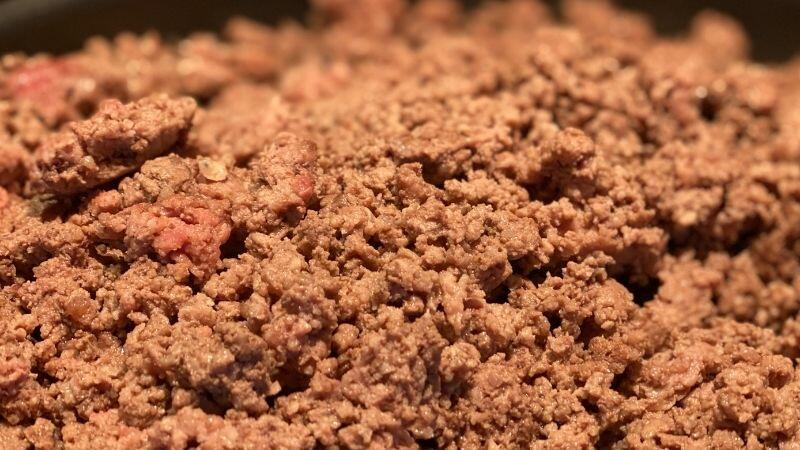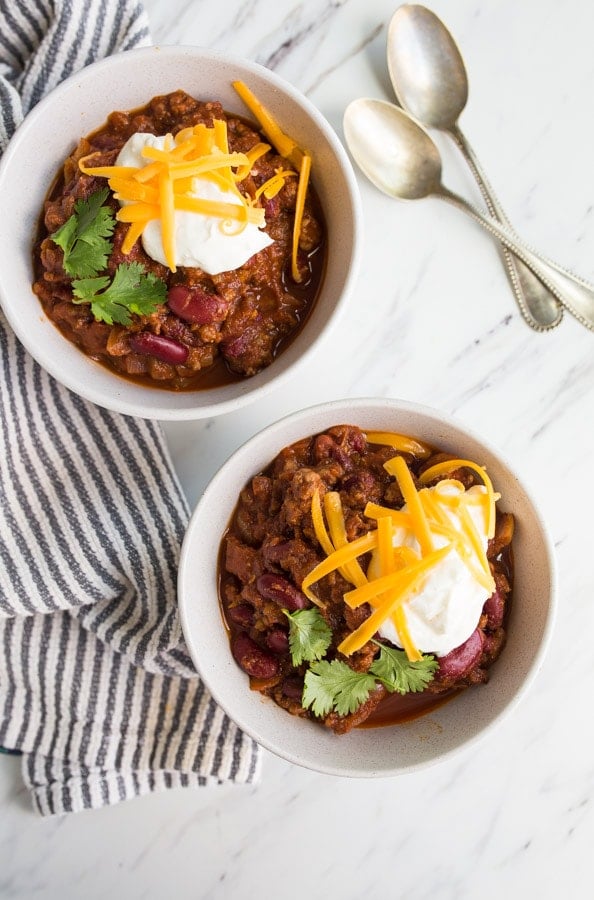This recipe for Easy Ground Beef Chili is the one my mom made when I was growing up. It came from her butcher, and we love that it only has seven ingredients! The flavors are strong, and everyone always eats all of it. Its great to make for a party and set out bowls of chili toppings.
Chili is a beloved staple of American comfort food. A hot bowl of chili can keep you warm on a cold day thanks to its hearty texture and warmth. But when people make chili, they always wonder if they should drain the extra fat from the ground beef before adding it to the chili. People have different ideas about whether draining the beef makes chili better or worse. This article will talk about the pros and cons of draining ground beef for chili vs. not draining it.
The Case for Draining Ground Beef
Here are some reasons you may want to drain fat from ground beef before using it in chili:
-
Reduces overall fat and calorie content – Draining fat lowers the total amount of fat per serving, This can help lighten up the dish
-
Less mess – Draining minimizes grease splatters if chili bubbles over or spatters when stirring
-
Leaner texture – Fat from beef can make chili seem overly greasy. Draining gives a leaner mouthfeel.
-
Easier ingredient integration – Ground beef crumbles more evenly when drained, allowing better distribution of onions beans etc.
-
Keeps focus on spices – Removing fat allows other flavors like chili powders and cumin to stand out rather than just tasting meaty.
For those monitoring fat intake or wanting a lighter, less oily chili, draining ground beef can be beneficial.
Reasons to Skip Draining Ground Beef
On the other hand, here’s the case for using beef fat in chili:
-
Preserves beefy flavor – Fat carries a ton of meaty flavor. Draining can make chili taste flat and one-dimensional.
-
Adds richness – The unctuous quality fat provides gives chili a more luxurious, mouth-coating texture.
-
Helps sauce thicken – Fat enables the chili sauce to thicken and coat beans and veggies instead of being watery.
-
Improves the infusion of spices—Herbs and spices soak into fat, letting their flavors grow and become stronger.
-
Saves time – No need to dirty extra bowls and deal with messy grease when skipping draining.
For maximum depth of flavor and velvety texture, keeping beef fat in chili has advantages.
Key Factors to Consider
If both sides have good points, what should decide whether ground beef should be drained for chili or not? Think about these things:
-
Fat content of beef – Fattier cuts like chuck benefit more from draining than leaner beef like sirloin.
-
Other ingredients – More veggies, beans, etc. means less relative fat per bite, so draining may not be needed.
-
Cooking method – Chili simmered uncovered on the stovetop concentrates fat flavors more than slower cooked chili.
-
Desired consistency – Drain for a thicker, drier texture versus leaving fat for a saucy, gravy-like consistency.
-
Health factors – Draining can help limit fat and calories for those with dietary concerns.
-
Personal preference – Some simply don’t like the mouthfeel of greasy chili while others cherish it.
So think about your specific recipe, blender of spices, and personal preferences when deciding about draining ground beef for your next pot of chili.
How to Drain Ground Beef for Chili
If opting to drain, here are some tips for doing it effectively:
-
Use a large skillet to brown beef over medium-high heat, breaking it into crumbles as it cooks.
-
Once no longer pink, transfer beef with a slotted spoon to a bowl lined with paper towels.
-
Let sit 1-2 minutes for towels to absorb grease. Pour off any accumulated fat from the bowl.
-
Add desired amount of dried beef crumbles to the chili pot and proceed with recipe.
-
For maximum fat removal, consider rinsing the crumbles with hot water after draining. Pat thoroughly dry before adding to the chili.
Alternatives to Draining Fat from Beef
If you want to keep the fat but lighten your chili, here are some options:
-
Use a fattier cut like chuck but use less total beef.
-
Mix in extra veggies, beans or masa to cut the relative fat ratio per bite.
-
Blend in shredded chicken breast for a leaner hybrid beef and chicken chili.
-
Top each bowl with a dollop of plain Greek yogurt or avocado for a cool, fatty contrast to the chili.
So while the draining debate wages on, a few tweaks can let you have the best of both worlds in your chili!
At the end of the day, do what seems right for your personal tastes and dietary needs. Because whether you pour

Should chili be thick or soupy?
To make chili soupy, you can add more beef broth. I like my chili thick. If you hot-plate chili that has been chilled or frozen, you may need to add a little beef broth to help it stick together.
Simple Chili Recipe for Two
This recipe is great because it makes a smaller amount of chili. I don’t need a gallon of chili sitting in my fridge. This recipe for ground beef chili only makes enough for 4 bowls; there are no leftovers! My family eats it for dinner one night and for lunch the next day.
So, my family really does eat it by making it the night before and then having it for dinner the next day. Chili tastes even better after it sits overnight in the fridge. When we have leftovers, I suddenly want lunch at 10:30am, hah!.
Fire-roasted green chiles are one of my favorite things to keep in my pantry. I love them! If you like fire-roasted green chiles, check out my recipes for green chile chicken enchiladas, green chile stew, and chile and cheese stuffed chicken breast.

How to separate Fat from Ground Beef – 60 second video – Recipes by Warren Nash
FAQ
Should you drain fat from beef for chili?
Should you drain the fat from ground beef?
Do you have to cook ground beef before making chili?
How do you make chili with ground beef?
Use ground beef with a higher fat content. Fat equals flavor, so 80% to 85% lean ground beef are good choices for chili. Cook the tomato paste. This is the key to really getting flavor from tomato paste. Plan to cook the tomato paste until it takes on a deep red flavor and is fragrant; the process takes just a few minutes. Bloom the spices.
Is it better to drain ground beef for chili?
Draining your ground beef for chili is a matter of preference.The best ground beef for your chili is one that hasn’t been drained, since most of the sweetness comes from the fat. Fat and water are lost when ground beef is drained. But undrained ground beef mixes well with chili ingredients. It keeps the flavor and makes the chili taste better.
How do you drain ground beef for chili?
Draining ground beef for chili is similar to draining ground beef for any other purpose. Simply drain the beef’s fat. You can drain your ground beef using a variety of methods. One of the best methods for draining ground beef is to place a colander over a bowl or pot and pour your cooked ground beef into the colander.
Is ground beef good for chili?
It’s an excellent choice for making hamburgers. Regular Ground Beef: has the highest fat percentage, about 25 to 30%. When using this type of beef in recipes that call for a lot of oil, it becomes a good choice. Draining ground beef for chili is similar to draining ground beef for any other purpose. Simply drain the beef’s fat.
